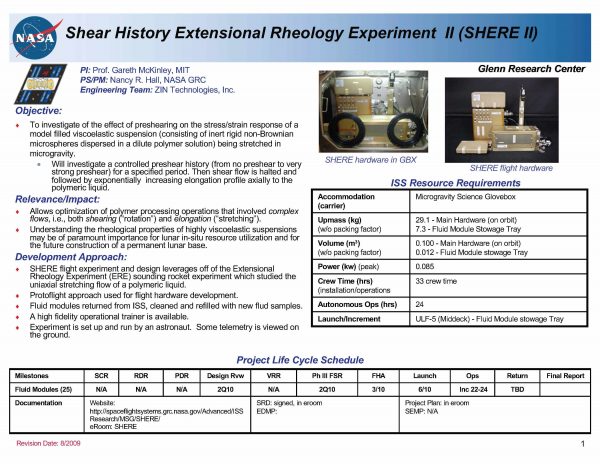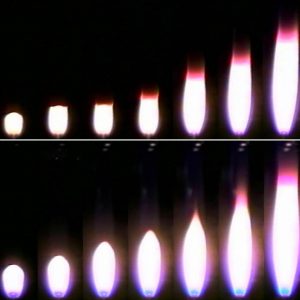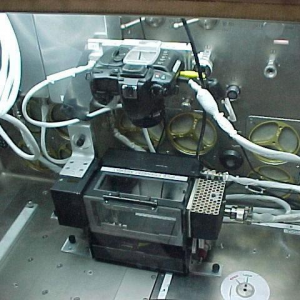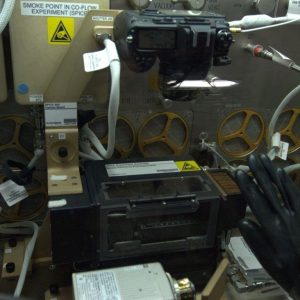SPICE
Smoke Point in Co-flow Experiment (SPICE)
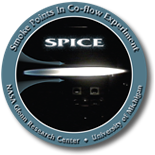
The Smoke Point In Co-flow Experiment will continue the study of fundamental phenomena related to understanding the mechanisms controlling the stability and extinction of jet diffusion flames begun with the Laminar Soot Processes (LSP) on STS-94. SPICE will stabilize an enclosed laminar flame in a co-flowing oxidizer, measure the overall flame shape to validate the theoretical and numerical predictions, measure the flame stabilization heights, and measure the temperature field to verify flame structure predictions.
SPICE will determine the laminar smoke point properties of non-buoyant jet diffusion flames (i.e., the properties of the largest laminar jet diffusion flames that do not emit soot) for several fuels under different nozzle diameter/co-flow velocity configurations. Luminous flame shape measurements would also be made to verify models of the flame shapes under co-flow conditions. The smoke point is a simple measurement that has been found useful to study the influence of flow and fuel properties on the sooting propensity of flames. This information would help support current understanding of soot processes in laminar flames and by analogy in turbulent flames of practical interest.
Research Overview
- Previous experiments show that soot dominates the heat emitted from flames in normal gravity and microgravity fires. Control of this heat emission is critical for prevention of the spread of fires on Earth and in space for the design of efficient combustion systems (jet engines and power generation boilers).
- The onset of soot emission from small gas jet flames (similar to a butane-lighter flame) will be studied to provide a database that can be used to assess the interaction between fuel chemistry and flow conditions on soot formation. These results will be used to support combustion theories and to assess fire behavior in microgravity.
- The Smoke Point In Co-flow Experiment (SPICE) will lead to a
- improved design of practical combustors through improved control of soot formation;
- improved understanding of and ability to predict heat release, soot production and emission in microgravity fires;
- improved flammability criteria for selection of materials for use in the next generation of spacecraft.
Science Objectives
The Smoke Point In Co-flow Experiment (SPICE) determines the point at which gas-jet flames (similar to a butane-lighter flame) begin to emit soot (dark carbonaceous particulate formed inside the flame) in microgravity. Studying a soot emitting flame is important in understanding the ability of fires to spread and in control of soot in practical combustion systems space.
Science Results
The Smoke Point isn’t a break room for those who like to light up, it’s the point at which gas-jet flames begin to emit soot. Studying soot-emitting flame advances our understanding of fire safety in space. This investigation completed 250 combustion tests with various fuel mixtures, including propylene, propane, and ethylene, in microgravity. Researchers identified more than 70 smoke points, which yielded estimates of soot-forming conditions and flame dimensions. The data will help researchers understand how smoke points are affected by microgravity and co-flowing air speed, or air flowing in the same direction as fuel gas.
Space Applications
Current NASA spacecraft materials selection is based upon a simplified test method that segregates material based upon behavior on Earth without real consideration of microgravity effects. A critical element of this understanding is the radiative heat emission from the flame. This heat emission is strongly influenced by the extent of soot formation. Improved understanding of soot formation and thereby the heat release from microgravity fires will allow more complete and effective utilization of the flammability test results. These results can be used in first-order models and predictions of heat release in spacecraft fires and as a means to extend heat release data from tests like the NASA cone-calorimeter test to microgravity fires to a performance based material selection process.
Earth Applications
The smoke-point phenomena is a classical metric in the understanding of the heat release and spread rate of fires. It is commonly used in fire modeling on Earth and to understand the soot growth and emission by flames. The dominant characteristics of many flames of practical interest are nonbuoyant. SPICE seeks to extend our understanding by looking at the interaction of ambient flow with the smoke point, enabling us to better predict heat release from non-buoyant flames in practical combustors (e.g., jet engines and furnaces).
Gallery
SPICE Contacts
Project Manager: Robert Hawersaat, NASA Glenn Research Center
Principal Investigator: Dr. David Urban, NASA Glenn Research Center
Co-Investigator: Prof. Peter Sunderland, U. Maryland
Project Scientist: Dr. Zeng-guang Yuan, NCSER
Engineering Team: ZIN Technologies, Inc.

